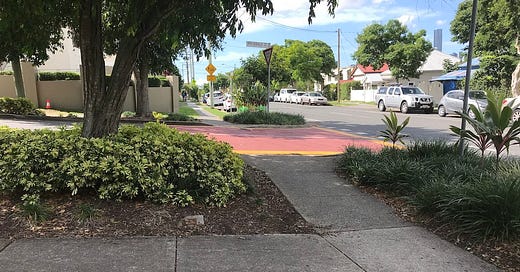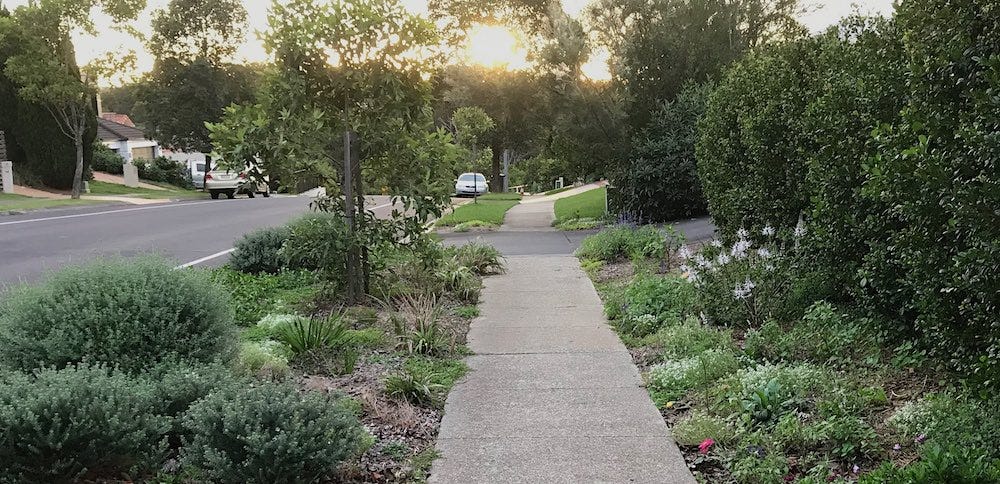Council versus Resident-planted Verge Gardens
Not only do I think we can’t expect Councils to plant all the verges for us, we don’t really want them to.
This is an update of an article from March 2021. Three years on we are still producing research on urban heat and talking about what should be done but, apart from a few isolated projects, there is far too little action on greening our cities. The predicted heatwaves are already here. What will you do this winter to plant in your garden, street, suburb, or city to prepare for next summer?
The Australian Conservation Foundation (ACF) released a report, Temperature check: Greening Australia's warming cities, by Monash University researchers, which shows increasing urban vegetation will become essential for our three largest cities – Sydney, Melbourne and Brisbane – to reduce serious heatwave impacts by 2060-2080.
I did an interview with ABC (story here) about the part that verge gardens play in cooling our cities for their story about the report. As a backdrop we used a garden near the studios at West End. Looking at it online, it seemed appropriate. It had street trees and low-growing plants below. When I arrived I had a look around.
It was clearly a garden done by the Council.
How do you tell?
It was a uniform design - same on both sides of this street, and the same design was on the next intersection. The plant palette was small - only 4 or 5 species - all tough and requiring minimal maintenance. But it was much better than barren grass verges for cooling, habitat and amenity. It complied with the regulations of no hard landscaping, no trip hazards, and maintaining sight lines. And when you walked along the path from sunshine into the shade, you could feel the temperature drop.
So, what was missing?
Like most streetscaping, this garden had came from outside the community with no connection to the surrounding residences. There was no gardener to stop and chat to, none of the individuality or serendipity you get with many resident-planted verge gardens. It didn’t feel like a place that anyone living nearby really cared about.
One of the comments I get for my verge garden is that people like to see what has changed with the seasons (and the gardener’s whim) as different plants flower and new plants are added. But this garden lacked that sense of change. There was a solitary blue-banded bee on a liriope flower but not enough biodiversity to cater for butterflies or lizards or small birds like fairy wrens.
Even in the smallest of gardens there are microclimates. Plants are chosen according to where soil has more or less moisture, where there is more or less shade, where they are protected from the wind. That encourages a much more diverse group of plants.
Gardening is also an ongoing activity. The garden evolves as plants are tried to see how they fare in a location, and pioneer plants are replaced as other plants take over. Some do better and some worse than we expect. We often use annuals to fill gaps while the shrubs grow. Official gardens don’t do this - they aim at set and forget with minimal maintenance so plants are chosen on their ability to survive. That’s why they use plants that even the councils themselves often acknowledge are non-native weeds.
So not only do I think we can’t expect Councils to plant all the verges for us, we don’t really want them to. As well as the cost and taking far too long when increasing habitat and cooling our cities is a priority, a city full of uniform, unexciting verge plantings is not what we need.
But Councils do have a very important role to play. I believe that street trees should normally be left to Councils for several reasons:
It is Councils’ responsibility to monitor and increase tree canopy with a good mix of trees suited to the current and future climate. They have access to far more research on that than the average gardener.
Councils employ arborists to select trees, and trim and raise the canopies as the trees grow.
The street trees are the thing that provides a unified theme to the neighbourhood.
I also think Councils should provide policies and guidelines for verge gardens and residents should comply. Again there are several reasons:
Councils are used to thinking of the different stakeholders - pedestrians, services, vehicle traffic, etc.
Some gardeners - not you or me of course - will plant silly things if given free reign. Things like weedy species, spiky plants that attack pedestrians, taller shrubs and trees that whack people in the face as they walk or cycle by and block the view of traffic.
Councils can do the research and recommend plants. Some councils suggest a special plant selection for bushfire prone areas. Let’s all use that local knowledge.
Somebody has to be the bad guy and tell people to remove a really bad verge garden. The policy determines what is acceptable, and what isn’t.
Making it happen on individual gardens
The initial conversion from grass to garden is the hurdle that stops many people. Sometimes it’s the work involved, sometimes it’s just not knowing where to start or what to plant.
For individual gardeners converting their own verge, the free Verge Garden Basics - Understanding the Space course is for you. That has the lessons I learned when doing my verge. And there is also a large facebook group where you can see what others are doing at https://www.facebook.com/groups/reverge
These individual nature strips are where low-key gardening, changing a small patch of grass to a garden to see how it goes, then convert a little more, and a little more, works best. You adapt to the weather, removing grass and weeds by hand after rain, planting tubestock and seedlings which requires minimal digging. Using plants native to the area avoids the need for extensive soil remediation. Avoiding food plants also avoids the worry about contamination and need for soil testing.
For this, Council guidelines need to be broad, self-assessable, and free for a standard verge.
That means councils have to break out of the corporate landscaping mindset of projects, planning, and permits. Fortunately many councils have done this, providing guidelines where residents don’t need to apply for permits unless they want to go beyond a simple garden. Why waste time and money on all that administration for every single verge garden? Why make it hard for residents who just want to replace grass with an inoffensive garden by demanding plan drawings of a completed and static garden and money for a permit?
Making it mainstream
To make a real difference to cooling our cities and creating habitat, we have to plant on every idle piece of land we have. Native habitat verges would replace mown turf and weeds as the norm. To do that will take more than volunteer gardeners working alone.
That is the aim of the Shady Lanes Project and examining the business models, organisational and social cultures that are needed to make it possible is one of the things I am concentrating on. The first step is local groups running projects to support their community to convert their own verges.
If you are interested in doing more than just your own verge, please consider joining our group of change-makers.
Happy Planting





